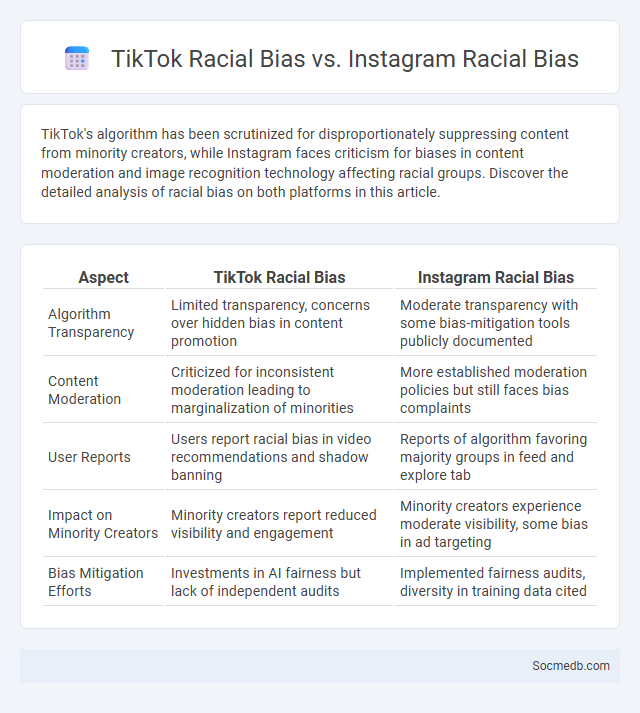
Photo illustration: TikTok Racial Bias vs Instagram Racial Bias
TikTok's algorithm has been scrutinized for disproportionately suppressing content from minority creators, while Instagram faces criticism for biases in content moderation and image recognition technology affecting racial groups. Discover the detailed analysis of racial bias on both platforms in this article.
Table of Comparison
| Aspect | TikTok Racial Bias | Instagram Racial Bias |
|---|---|---|
| Algorithm Transparency | Limited transparency, concerns over hidden bias in content promotion | Moderate transparency with some bias-mitigation tools publicly documented |
| Content Moderation | Criticized for inconsistent moderation leading to marginalization of minorities | More established moderation policies but still faces bias complaints |
| User Reports | Users report racial bias in video recommendations and shadow banning | Reports of algorithm favoring majority groups in feed and explore tab |
| Impact on Minority Creators | Minority creators report reduced visibility and engagement | Minority creators experience moderate visibility, some bias in ad targeting |
| Bias Mitigation Efforts | Investments in AI fairness but lack of independent audits | Implemented fairness audits, diversity in training data cited |
Understanding Racial Bias on Social Media Platforms
Social media platforms exhibit racial bias through algorithmic content recommendations that disproportionately favor or suppress certain racial groups, impacting visibility and engagement. Your interactions, including likes and shares, influence these algorithms, potentially reinforcing stereotypes or marginalizing minority voices. Recognizing these biases helps you critically evaluate content and advocate for more equitable digital spaces.
TikTok’s History of Racial Bias: Key Incidents
TikTok has faced multiple allegations of racial bias, including shadowbanning content from Black creators and moderating videos with racial or culturally sensitive themes more harshly than others. These actions sparked widespread criticism and led to internal audits and commitments to enhance algorithmic fairness and content moderation transparency. Despite efforts to address these issues, challenges persist in ensuring equitable treatment of diverse creators on the platform.
Instagram’s Approach to Racial Representation
Instagram's approach to racial representation centers on promoting diversity and inclusion through curated content and algorithmic adjustments. The platform actively supports creators from underrepresented communities by amplifying their voices and spotlighting culturally significant narratives. Efforts include updating community guidelines to combat racial bias and collaborating with advocacy groups to foster equitable representation across its global user base.
Comparing TikTok and Instagram’s Moderation Algorithms
TikTok's moderation algorithms prioritize rapid content filtering using AI-driven pattern recognition to detect harmful videos, while Instagram relies on a combination of AI and human reviewers to manage posts and comments across its platform. TikTok's approach often results in quicker removals, but Instagram's hybrid system aims for more nuanced content evaluation to reduce false positives. Understanding these differences can help you choose the platform that best aligns with your content safety preferences and moderation expectations.
How Algorithmic Bias Shapes Content Visibility
Algorithmic bias in social media platforms influences content visibility by prioritizing posts that align with users' existing preferences and behaviors, reinforcing echo chambers. These biases stem from training data and algorithm design, often marginalizing diverse viewpoints and amplifying popular or sensational content. As a result, content visibility becomes skewed, affecting user exposure to a balanced range of information and perspectives.
Case Studies: Discrimination on TikTok vs Instagram
Case studies reveal different patterns of discrimination on TikTok and Instagram, with TikTok often facing criticism for algorithmic bias that amplifies certain racial and gender stereotypes, while Instagram exhibits more overt content moderation challenges related to hate speech and harassment. Research shows that TikTok's recommendation system can inadvertently marginalize minority creators, affecting your visibility and engagement compared to Instagram, which struggles with inconsistent enforcement of anti-discrimination policies. Understanding these platform-specific issues helps identify the unique ways social media impacts marginalized groups and informs strategies for promoting inclusivity and equity.
User Experiences of Racism Across Platforms
User experiences of racism across social media platforms reveal persistent challenges such as targeted harassment, hate speech, and algorithmic bias that amplify discriminatory content. Platforms like Facebook, Twitter, and Instagram implement varying degrees of moderation tools and reporting mechanisms, yet many users report inconsistent responses and inadequate protections. Your engagement with social media requires awareness of these risks and proactive use of privacy settings and support networks to mitigate exposure to harmful racial content.
The Role of Platform Policies in Mitigating Bias
Social media platform policies play a critical role in mitigating bias by enforcing guidelines that promote diverse content and prevent discriminatory behavior. Algorithms designed to reduce echo chambers and promote balanced viewpoints help curb the spread of misinformation and biased narratives. Regular audits and transparency reports from platforms like Facebook and Twitter enhance accountability and drive continuous improvement in addressing systemic biases.
Strategies for Algorithmic Fairness and Inclusivity
Strategies for algorithmic fairness and inclusivity in social media involve designing algorithms that mitigate bias and promote diverse representation across content feeds and recommendations. Incorporating diverse datasets and continuous auditing mechanisms helps ensure equitable treatment of all user demographics, reducing algorithmic discrimination. You can enhance your social media experience by engaging with platforms that prioritize transparency and actively implement these inclusive algorithmic practices.
The Future of Racial Equity in Social Media Algorithms
Social media algorithms increasingly shape user experiences, raising concerns about implicit biases affecting racial equity. Advances in AI and machine learning offer opportunities to design fairer algorithms that minimize discrimination and promote diverse representation. Transparent data practices and inclusive development teams are crucial for ensuring social media platforms foster equitable digital environments.
 socmedb.com
socmedb.com